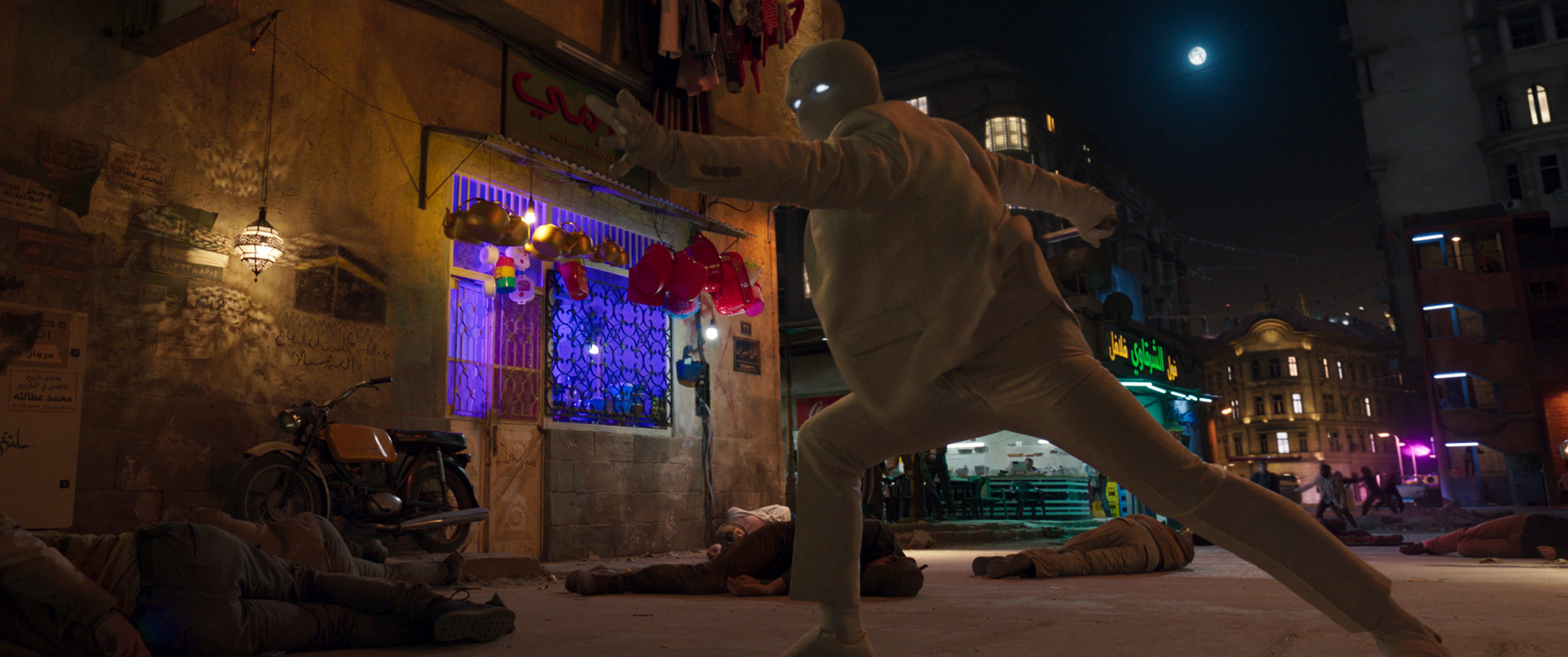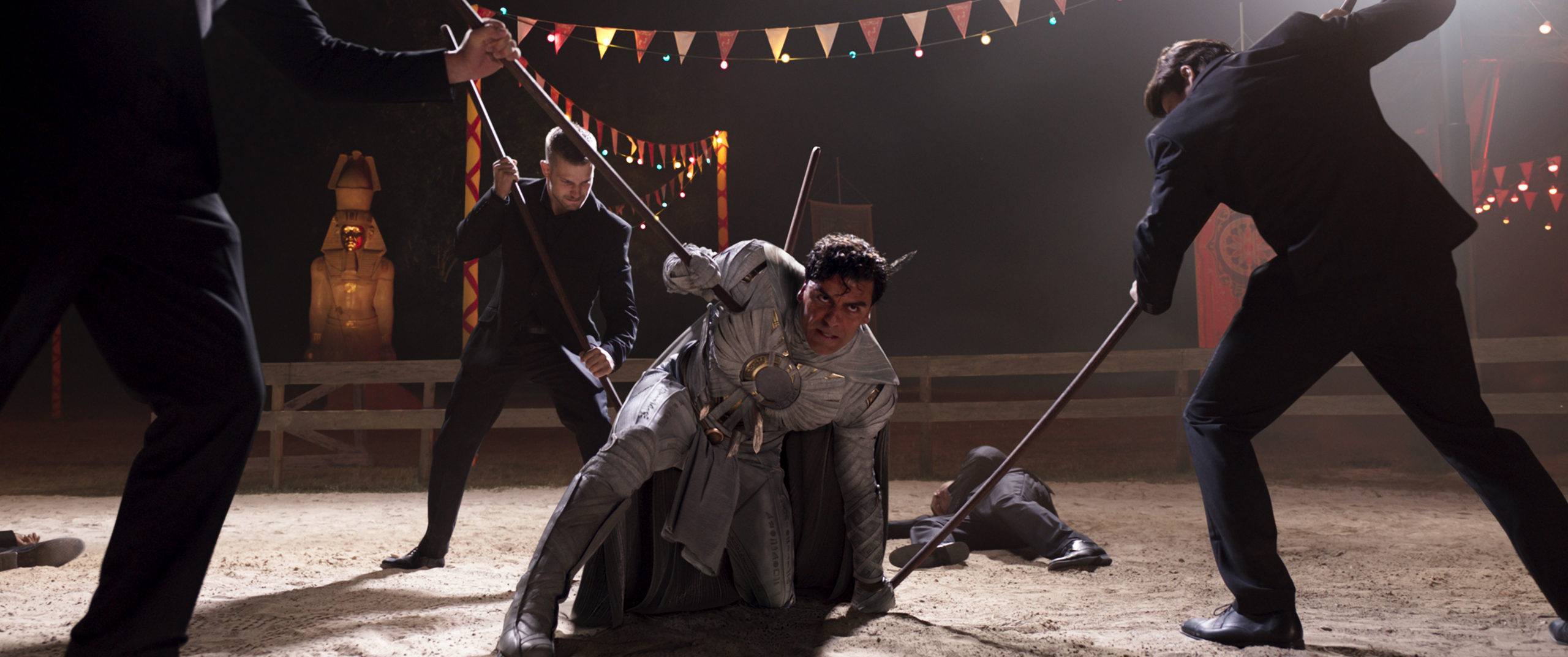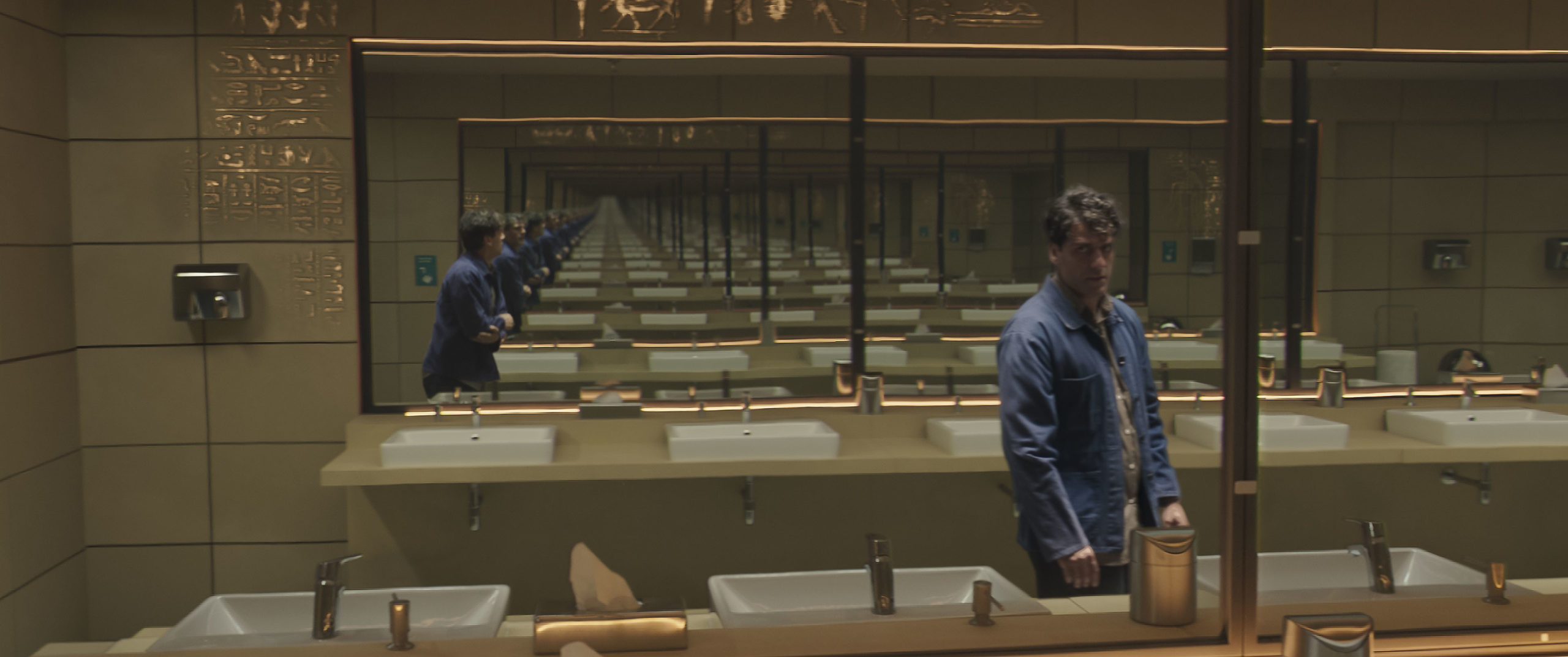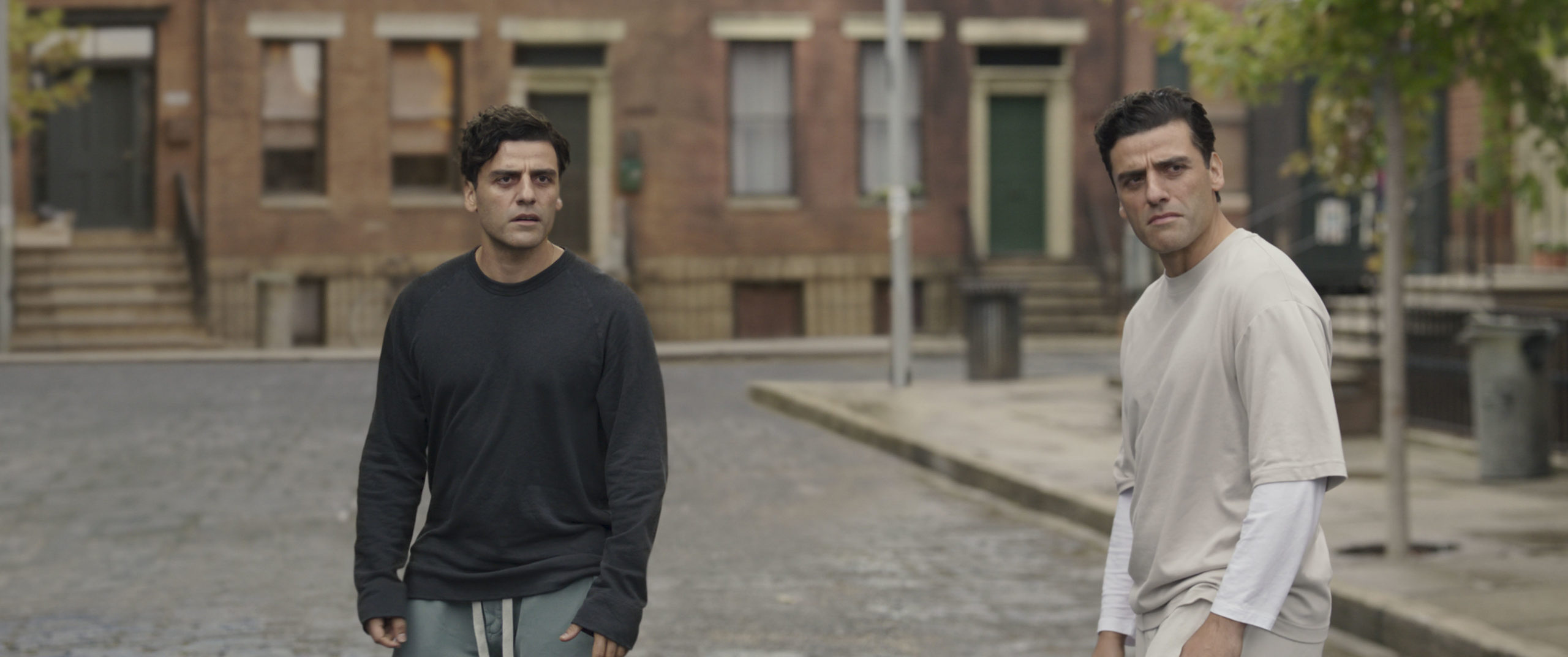
Steven Grant (Oscar Isaac) in Moon Knight (Disney+)
Gregory Middleton is an Emmy nominated cinematographer for Games of Thrones, Watchmen and Moon Knight. In a career spanning many years, he has had the opportunity to collaborate with some industry greats, working on some era defining television projects. He recently took time out, in light of his fourth Emmy nomination for Moon Knight, to talk to Martin Carr about his passion for cinematography.
For you, what is the primary purpose of the cinematographer?
There are two major parts to it, the first from a technical standpoint. We are charged with the running of the lighting and the grip of the camera to help execute the photography of the show. When I say photography I mean everything you see of the images in the movie, the lighting, the camera and how it all works.
The second part would be the artistic interpretation and trying to figure out how to photograph the scenes with the director.To figure out the filming style, look at visual references, then figure out what the strategy would be for the approach to filming.
From a basic standpoint, we would be behind the camera cranking it with one assistant. Now if it’s much bigger with a larger camera and crew, sometimes I would be on the camera operating it myself. Usually I also supervise a larger team of camera operators and assistants. In the main, everything you see of the actual photography I would oversee.
Moon Knight has such a unique set of challenges, not least of which was having the same actor (Oscar Isaac) interact with himself. How did you approach that particular obstacle?
There were a couple of things that were particularly challenging about this. One was from the point of view of story, where we had the film making style mimic the point of view of the character. One example is where Steven was essentially being haunted, so we were trying to keep the camera from his perspective. Later on his multiple personalities manifest themselves as two people, so Oscar is playing two parts, not just in the mirror reflection but also acting with himself. Throughout the most important thing for us, similar to our mirror work, was not to create a technique that needed to be so precise that it would restrict Oscar’s performance.
The first step would be to figure out who was driving the scene, which character is more motivated. Basically once one pass has been done with one actor, the other one has to keep pace with that. So first of all Oscar needed to decide which character was driving the scene, which has more motive, is Steven catching up to Marc or the opposite. That would decide which technique we used.
If we are going to move the camera in a 3D space, on a dolly or track, we record that move, then Oscar has to keep pace with that move afterwards. So if we have at least done it with his performance in mind the first time, it should be more natural that way. The tricky part is the stunt scenes, where he wanted to have more freedom.
For example, the scene at the end of episode one, when he is in the bathroom mirror, Steven is freaked out and chased by a jackal in the museum. Oscar wanted to be able to walk back and we had to pan down one side of the mirror to see one version as Marc marches back, then back to him, all in one shot. That had to be very carefully rehearsed. The camera didn’t want to be under much control because the physical activity of him backing up quickly was so precise. To keep the style of being with him and keep that point of view, it was better to do it on Steadicam and be more active.That required more precision than if you were doing it another way.
If you are doing twinning and don’t want to be recording with the camera, you have to make sure you are not moving too much in the space when you see both people. When you are doing split scenes, you are not really moving in the 3D space too much. We can split the scenes with him twinning into three or four techniques.
Obviously when we don’t see both of their faces we can use a double. Oscar used his brother Mike as his acting double. So Mike would come and do all the scenes with him. Oscar fought for this and it was an incredibly smart idea. Mike is a very good actor and he knows him very well. He would help Oscar work out the two characters when he was rehearsing a scene.
Mike could act the character in audio when not on camera to keep the pace the same. So if we are doing split screen for example, Mike could be on camera with him while we were filming the half of the scene with Oscar, then we would flip and film with Mike so that they could memorize the timings.
So there were a variety of techniques and it would all depend on what was best for the scene. There were significant time limits, this wasn’t a feature where we had a lot of time to do every shot in the most elaborate way. One day with a scene like this we had to do a series of close ups and then two or three twinning shots, that we would have to try and do with one set up.
We would hide cameras in the other doorways to try and get other shots we could get at the same time. Changing Oscar up with wardrobe and make up and just the brain power of becoming the performance, it was hard for him to go back and forth between takes. So we were trying to do all one character first, and all of the other character second. That meant a lot of discussions around how to actually get that kind of work done in one day.

Marc Spector (Oscar Isaac) in Moon Knight (Disney+)
From your perspective on Moon Knight, how have effects-heavy projects changed cinematography?
There are a couple of different things that have affected the way we work in cinematography. The first couple of films I worked on we didn’t even have a video tab. Back in the olden days it was just me on the camera saying ‘yes the take was good’, there was no direct link to the actors, they are looking to you for opinions. That still exists with a couple of big changes.
We use monitors now, we can project a good image onto the monitor, so you can see something much closer to the final image. The directors love that, everyone loves to see the details of things, to make changes to the costumes and lighting and stuff. The lighting is now more challenging for us because now everyone is watching what we are doing. When we were only on film the final photography and how it looked to the eye was much more up to us, because we were the only ones really able to see it.
The bigger fact is that there is more work now with what happens to the actual image in the photographic sense. The biggest part is the actual photography, since we now have a lot of tools we can play with. When we were only on film, changes were limited to the colour of light we could push through the image. Now we have things like Photoshop, just think of what you can do even on a phone now.
All the technology merges its way into how that digital image is finished in photography. There are a lot of things we can do now with the gamma curve, change certain colors, or alter certain areas in the image to the point that it requires some discipline, otherwise you can get lost. It also takes away ownership to a certain degree.
I now work with a talented colourist who is an expert in the technology. They are a great person to collaborate with in that way. It also takes it into a space where producers and the studios have more direct access and they will have ‘their’ final colour pass. Ideally, if I have done my work creatively and I have a good relationship with them and they want something similar to what I want. However, it does take it into a space where it can be taken away from me. Some cinematographers have fought to keep control of the photography. Not let it go off the rails and try to keep everyone on board and not lose control.
The flip side is visual effects, because when you are doing visual effects it is traditionally one of the last things that happens. Even when I am colouring a show now and I’ve done a lot of work in pre-production, the final version might not be ready until a couple of weeks before it releases.
Colouring the whole image is very tricky, because I am doing it blind based on what I hope will be in the background. There were times in Moon Knight where they do a lot of visual effects quite late, purely because they have a lot of work to do on a very tight schedule. When a lot of the scenes were finished I would only get one pass at it, then I would be relying on the colourist to remember my little things because he is doing it very very late in the process. So there is an element of that which drags up problems and makes the mix more complicated.
The other part is pre-production. Traditionally on location based films, we would scout a lot of places together, take some photographs and then figure out where we are going to shoot. We would go on a survey and decide all of those things. We might draft storyboards or take photographs from the positions that we want, then come up with a finer plan based on what we have seen.
With visual effects, particularly with animation, there is often more of a pre-vis done with quite simple animation, with a proxy design for the set, characters and design shots, especially with things like virtual characters. That’s a whole team of pre-visualisation artists that are in the visual effects departments, sometimes working for the studio directly, sometimes working for the visual effects company. They are very important for budgeting out the visual effects, how many shots, how many elements, CG characters, what the background is going to be, and that happens quite early.
From the photography standpoint, for me, I have to be involved early enough so that I can make sure that the real elements are the way I would like them to be. For example, one of my first years on Game of Thrones, there was a scene with Daenerys on her balcony on the pyramid. I wanted it to be early dawn, the sun had just come up, she had been up all night. It would be nice to use that set in a way I had not seen before, creating a step in the mood and tone for the episode.
I pitched a bunch of concepts to the visual effects supervisor. If I pitched an idea I could be involved in how the sky would look and light her in the way I would like the sky to feel, and have control of the entire thing. If we were on location I would say we need to be on set at 5.45am when the sun comes up over that mountain, that’s the way we would normally do it.
On Games of Thrones we had pyramids in a studio so it was a visual effects extension. It’s an opportunity for me to use visual effects to help create the mood and be involved in that process. Another example is episode one of Moon Knight, in the bathroom sequence, the whole thing needed a lot of planning because of the mirrors and everything. The last shot of the fight was always going to be off camera, the idea was that they were going to reveal him afterwards.
Originally he was going to step into the hallway. I thought it would be interesting to see him, see the water reflections, see all the debris, maybe see a glimpse of him from behind as he finishes killing the thing. That shot was mostly designed in pre-production as far as its execution and how it would look, and that was important. If I wasn’t involved there I would just be lighting a shot that I didn’t really have any influence over.
So what has happened in the last ten years, has extended our interaction with the entire product from beginning to end. There is a lot more overlap in other areas that helps contribute to what the image becomes. There are way more teams to interact with and many more artists to collaborate with. You can do amazing things if you are all on the same page, between models and visual effects and stuff, it is really quite fantastic.
Moon Knight and Watchmen are both about a lot more than masked vigilantes. What piqued your interest in the former, when involvement in the latter might suggest opposing sensibilities?
There is a similarity that both are not about masked vigilantes, each story is a very different thing. Watchmen I am really proud of, they really go into the spirit of the original comic by making an extension of it. It became a story about trauma and healing. Ironically Moon Knight is also about trauma in a lot of ways. Watchmen is more of an ensemble approach, where there is a lot more iconography in the telling of the story. What they have in common is that they are both stories about a particular thing.
Moon Knight is more a character study – in the end it is about self-acceptance, the characters accepting themselves and the power to overcome things. They are really stories that are separate from what people think of when they think about comic books and a masked figure in a book. That’s the important thing for me – to tell stories that illuminate something about people and society. A compelling story that moves me emotionally, that you want to watch more than once, like a great song, or a piece of poetry or prose, it has to touch you emotionally.
Moon Knight was fascinating for a couple of reasons, in a way it is very mainstream as far as Marvel comics in general. But the character in the comic specifically has a lot of very devoted fans because he’s so out there. The stories told in the comics are even more crazy than in the show. Bringing in all those ideas, like where dreams come from and what comes into dreams. All that stuff is very fascinating visually, but the most important part is that it is moving.
By the end Steven basically sacrifices himself to save Marc, at the beginning they hate each other, and they are the same person. To see that journey of self acceptance is something I find very moving. It provided a great opportunity to create a moving emotional story, especially with someone as incredible as Oscar tackling that character and creating a great dark mirror to see this character through.
Also the idea of all the magic tricks, for example, at the beginning in Steven’s apartment where he has a fish tank, we were discussing the conceptual part of the script. Originally there was going to be confetti to represent the trail so that he didn’t sleepwalk. So we thought, what if we use sand, we are using sand in the fish tank and we can make the fish tank sand similar to the Duat sand that comes later.
One thing I am fascinated about is when you come up with ideas or dreams, you always pull things from reality, from what we have seen, that is just how the mind works. So the idea that the fish tank should have things in it that come up later in the story, the sand from Duat, the barge, the Gates of Osiris, a little pyramid, these things are all in there.
If the Duat was in his imagination, these things would come from his mind, then it would come from stuff he is imagining and the Egyptian stuff he loves. Having discussions of what to do visually, how to use the camera and what to place in the background was super fun. It is not something that all shows use prominently in film making to create that point of view for the character.

Steven Grant (Oscar Isaac) in Moon Knight (Disney+)
Having worked on both, what do you think they add to the creative conversation around shared universes?
When we started Watchmen we didn’t know that it was going to finish with that season. When I joined they had done a pilot which we re-shot, but that went on to form what would be the nine episodes. It was a bit of a journey of discovery I think for Damon and everyone else. That there was a single story here that I can get to, an end point that I am happy with. It can sort of mirror the end of the original Watchmen comic which was basically saying ‘was it worth it’. He’s done his duty, he’s killed millions of people, he thinks he’s united humanity, and as it turns out, no he hasn’t, the cycle continues.
There was an element of that at the end of the series for Damon. What if someone else gets Dr Manhattan’s power, would it create a similar journey to Manhattan himself, would that change anything or start the same cycle again. Once he had figured that out and decided that it was a one time sort of thing, as far as the Universe goes, he didn’t want to make another series like that. It was not something he wanted to do and frankly It nearly killed everyone involved.
It was such a complicated thing to crack, I think there were something like 200 days of writers notes or something like that. It was sometimes so complicated in meetings, with Damon and I getting confused about something because there had been so many permutations.
Maybe there’s another way to tell another story in that Universe, honouring that material, I think Damon thought that might be possible. If someone had an interesting idea for that, it is something HBO would consider letting another creator try.
Moon Knight is something different, the character is very fascinating. What Oscar helped create for the universe is the spoiler at the end of the series introducing Jake. I can’t speculate too much, but the stuff in the comics about the three characters is really interesting and we don’t really know what Jake is like.
Jake has a real dark side, where does he come from, how does he relate to that stuff. From a world building perspective in the MCU a lot of stuff is about putting things together. His character would be an amazing addition to an ensemble of certain characters, because he is such an interesting guy.
I think there is a comic called the Midnight Suns that has a lot of mystical characters. I could see him with a group of characters bouncing between personalities, that could be fantastic. I think there are some possibilities there, but I don’t know anything, that would be all up to them. I know nothing and I wouldn’t be able to say anything if I did (laughs).
Describe for me your perfect Sunday afternoon?
If it was summer, two or three of my good friends always go on a kayak camping trip every year. Kayaking is really fun, just waking up, making breakfast on a fire on the beach on one of the Gulf islands here on the west coast of Canada. Those are some of the best afternoons I have had in my life, especially with this group of friends who are like family to me. Around this time of year is when we would usually do the trip, so that is on my mind just now.
Either that or something else. I started making films as a kid, I loved making Super 8 movies for my friends. I feel incredibly fortunate to be doing what I do now and work in the spaces I am in and with the incredible people I work with. There are days when I’m just popping by the stage to sit there and think about how I want to do something or consider some lighting ideas, acting out scenes with other people, like the director and stuff if we are planning out things. That is stuff I really do enjoy and I am really grateful I can do that and I have had many good Sunday afternoons doing that as well.
We would like to thank Gregory Middleton for taking part in this interview.

Steven Grant and Marc Spector (Oscar Isaac) in Moon Knight (Disney+)


